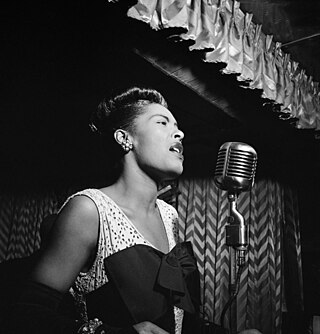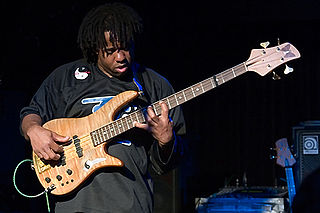
Accordions are a family of box-shaped musical instruments of the bellows-driven free reed aerophone type. The essential characteristic of the accordion is to combine in one instrument a melody section, also called the diskant, usually on the right-hand keyboard, with an accompaniment or Basso continuo functionality on the left-hand. The musician normally plays the melody on buttons or keys on the right-hand side, and the accompaniment on bass or pre-set chord buttons on the left-hand side. A person who plays the accordion is called an accordionist.

A cappella music is a performance by a singer or a singing group without instrumental accompaniment, or a piece intended to be performed in this fashion. The term a cappella was originally intended to differentiate between Renaissance polyphony and Baroque concertato musical styles. In the 19th century, a renewed interest in Renaissance polyphony, coupled with an ignorance of the fact that vocal parts were often doubled by instrumentalists, led to the term coming to mean unaccompanied vocal music. The term is also used, rarely, as a synonym for alla breve.

The double bass, also known simply as the bass, amongst other names, is the largest and, therefore, lowest-pitched chordophone in the modern symphony orchestra. Similar in structure to the cello, it has four, although occasionally five, strings.

Music is generally defined as the art of arranging sound to create some combination of form, harmony, melody, rhythm, or otherwise expressive content. Definitions of music vary depending on culture, though it is an aspect of all human societies and a cultural universal. While scholars agree that music is defined by a few specific elements, there is no consensus on their precise definitions. The creation of music is commonly divided into musical composition, musical improvisation, and musical performance, though the topic itself extends into academic disciplines, criticism, philosophy, and psychology. Music may be performed or improvised using a vast range of instruments, including the human voice.

A musical ensemble, also known as a music group or musical group, is a group of people who perform instrumental and/or vocal music, with the ensemble typically known by a distinct name. Some music ensembles consist solely of instrumentalists, such as the jazz quartet or the orchestra. Other music ensembles consist solely of singers, such as choirs and doo wop groups. In both popular music and classical music, there are ensembles in which both instrumentalists and singers perform, such as the rock band or the Baroque chamber group for basso continuo and one or more singers. In classical music, trios or quartets either blend the sounds of musical instrument families or group together instruments from the same instrument family, such as string ensembles or wind ensembles. Some ensembles blend the sounds of a variety of instrument families, such as the orchestra, which uses a string section, brass instruments, woodwinds and percussion instruments, or the concert band, which uses brass, woodwinds and percussion.

An orchestra is a large instrumental ensemble typical of classical music, which combines instruments from different families. There are typically four main sections of instruments:

A song is a musical composition performed by the human voice. This is often done at distinct and fixed pitches (melodies) using patterns of sound and silence. Songs contain various forms, such as those including the repetition and variation of sections.
A musician is a person who composes, conducts, or performs music. According to the United States Employment Service, "musician" is a general term used to designate one who follows music as a profession. Musicians include songwriters who write both music and lyrics for songs, conductors who direct a musical performance, or performers who perform for an audience. A music performer is generally either a singer who provides vocals or an instrumentalist who plays a musical instrument. Musicians may perform on their own or as part of a group, band or orchestra. Musicians can specialize in a musical genre, though a good number of musicians play a variety of different styles depending on cultures and backgrounds. A musician who records and releases music can be known as a recording artist.

Musical composition can refer to an original piece or work of music, either vocal or instrumental, the structure of a musical piece or to the process of creating or writing a new piece of music. People who create new compositions are called composers. Composers of primarily songs are usually called songwriters; with songs, the person who writes lyrics for a song is the lyricist. In many cultures, including Western classical music, the act of composing typically includes the creation of music notation, such as a sheet music "score", which is then performed by the composer or by other musicians. In popular music and traditional music, songwriting may involve the creation of a basic outline of the song, called the lead sheet, which sets out the melody, lyrics and chord progression. In classical music, orchestration is typically done by the composer, but in musical theatre and in pop music, songwriters may hire an arranger to do the orchestration. In some cases, a pop or traditional songwriter may not use written notation at all and instead compose the song in their mind and then play, sing or record it from memory. In jazz and popular music, notable sound recordings by influential performers are given the weight that written or printed scores play in classical music.

A bassist is a musician who plays a bass instrument such as a double bass, bass guitar, synthbass, keyboard bass or a low brass instrument such as a tuba or trombone. Different musical genres tend to be associated with one or more of these instruments. Since the 1960s, the electric bass has been the standard bass instrument for funk, R&B, soul music, rock and roll, reggae, jazz fusion, heavy metal, country and pop music. The double bass is the standard bass instrument for classical music, bluegrass, rockabilly, and most genres of jazz. Low brass instruments such as the tuba or sousaphone are the standard bass instrument in Dixieland and New Orleans-style jazz bands.

Bluegrass music is a genre of American roots music that developed in the 1940s in the Appalachian region of the United States. The genre derives its name from the band Bill Monroe and the Blue Grass Boys. Like mainstream country music, it largely developed out of old-time string music, though in contrast, bluegrass is traditionally played exclusively on acoustic instruments and also has roots in traditional English, Scottish, and Irish ballads and dance tunes as well as in blues and jazz. Bluegrass was further developed by musicians who played with Monroe, including 5-string banjo player Earl Scruggs and guitarist Lester Flatt. Monroe characterized the genre as, "Scottish bagpipes and ole-time fiddlin'. It's a part of Methodist, Holiness and Baptist traditions. It's blues and jazz, and it has a high lonesome sound."

A concert is a live music performance in front of an audience. The performance may be by a single musician, sometimes then called a recital, or by a musical ensemble, such as an orchestra, choir, or band. Concerts are held in a wide variety and size of settings, from private houses and small nightclubs, dedicated concert halls, amphitheatres and parks, to large multipurpose buildings, such as arenas and stadiums. Indoor concerts held in the largest venues are sometimes called arena concerts or amphitheatre concerts. Informal names for a concert include show and gig.

The steelpan is a musical instrument originating in Trinidad and Tobago. Steelpan musicians are called pannists.

Bassline is the term used in many styles of music, such as blues, jazz, funk, dub and electronic, traditional, or classical music for the low-pitched instrumental part or line played by a rhythm section instrument such as the electric bass, double bass, cello, tuba or keyboard.

The highly diverse and distinctive music of Madagascar has been shaped by the musical traditions of Southeast Asia, Africa, Oceania, Arabia, England, France and the United States over time as indigenous people, immigrants, and colonists have made the island their home. Traditional instruments reflect these widespread origins: the mandoliny and kabosy owe their existence to the introduction of the guitar by early Arab or European seafarers, the ubiquitous djembe originated in mainland Africa and the valiha—the bamboo tube zither considered the national instrument of Madagascar—directly evolved from an earlier form of zither carried with the first Austronesian settlers on their outrigger canoes.
Gagaku is a type of Japanese classical music that was historically used for imperial court music and dances. Gagaku was developed as court music of the Kyoto Imperial Palace, and its near-current form was established in the Heian period (794-1185) around the 10th century. Today, it is performed by the Board of Ceremonies in the Tokyo Imperial Palace.

Music of Jammu and Kashmir reflects a rich musical heritage and cultural legacy of the Indian-administered union territory of Jammu and Kashmir. Two different regions of Jammu and Kashmir consists the Jammu region and Kashmir Valley. Music of Kashmir Valley has influences of Central Asian music while music from Jammu region is similar to that of other regions of North India.

Acoustic music is music that solely or primarily uses instruments that produce sound through acoustic means, as opposed to electric or electronic means. While all music was once acoustic, the retronym "acoustic music" appeared after the advent of electric instruments, such as the electric guitar, electric violin, electric organ and synthesizer. Acoustic string instrumentations had long been a subset of popular music, particularly in folk. It stood in contrast to various other types of music in various eras, including big band music in the pre-rock era, and electric music in the rock era.

Classical music generally refers to the art music of the Western world, considered to be distinct from Western folk music or popular music traditions. It is sometimes distinguished as Western classical music, as the term "classical music" also applies to non-Western art music. Classical music is often characterized by formality and complexity in its musical form and harmonic organization, particularly with the use of polyphony. Since at least the ninth century it has been primarily a written tradition, spawning a sophisticated notational system, as well as accompanying literature in analytical, critical, historiographical, musicological and philosophical practices. A foundational component of Western culture, classical music is frequently seen from the perspective of individual or groups of composers, whose compositions, personalities and beliefs have fundamentally shaped its history.

The taal, manjira, jalra, karatala, kartal or gini is a pair of clash cymbals, originating in the Indian subcontinent, which make high-pitched percussion sounds. In its simplest form, it consists of a pair of small hand cymbals. The word taal comes from the Sanskrit word Tālà, which literally means a clap. It is a part of Indian music and culture, used in various traditional customs e.g. Bihu music, Harinaam etc. It is a type of Ghana vadya.

















